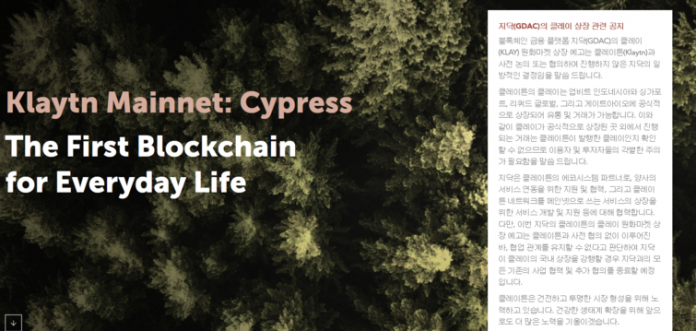

The exchange and virtual asset projects are in conflict with the right to list virtual assets (cryptocurrency). It is controversial that GDAC, a Korean virtual asset exchange, announced that it would list Klay, a virtual asset of blockchain project Klaytn, without prior arrangement with the project.
On the 11th, GDAC announced that it will list Klay on the KRW market and provide deposit and trading service of Klay starting from the 14th. However, GroundX, which issued Klay, did not discuss the listing in advance with the exchange, and said that if Peertec, the operator of GDAC, enforces the listing on the GDAC’s KRW market, it will consider the termination of the existing Klaytn partnership. GroundX said in the announcement, “Users and investors should be careful because it is impossible to verify Klay is issued by Klaytn in transactions other than the officially listed exchanges.”
▲ Klaytn’s stance on the listing / Source = Klaytn official website
GDAC refuted it. GDAC said the exchanges are independent screening body, so they do not need to ask for permission from the projects or consult with the projects to list blockchain-based projects.
Han Seung-hwan, CEO of Peertec, expressed his stance about the controversy through his SNS. He explained that the half of virtual assets on GDAC was listed without prior arrangement, and they could be listed thanks to the open source and autonomous ecosystem scalability of blockchain.
He said, “I respect GroundX’s decision.” “The final decision on listing will be made by GDAC, and we hope for GroundX’s understanding and respect for the role and responsibilities of the exchange,” he added.
He also refuted the announcement that it is not possible to verify that Klay traded at GDAC is issued by Klaytn or not. He said, “A centralized power cannot unilaterally manipulate the content in contents in blockchain, and recognition of the power is unnecessary for the ledger to be true.” “We can verify whether it is Klay issued by Klaytn based on the blockchain technology,” he added.
This is not the first case a listing has not been negotiated with the project. Last year, another Korean virtual asset exchange, Coinone, also listed the Cosmo Coin (COSM) of the blockchain project named ‘COSMOCHAIN’ on the exchange without prior arrangement. At that time, COSMOCHAIN said that it was unsatisfied with Coinone had not previously negotiated, but it was happy to be listed on major exchange. However, most people in the industry criticized Coinone.
At that time, Cha Myung-hoon, CEO of Coinone, expressed his stance through the SNS. He said, “The essential of the blockchain is decentralization.” “I wonder if all exchanges that listed Bitcoin have contacted Satoshi (the creator of Bitcoin) to list it,” he added. He also said, “If you want to control everything from the center, you can make T-money system, not blockchain.” “I think what Cosmo Foundation wants is not to create the value through blockchain, but to increase the price through listing on the desired exchange,” he pointed out.
Regarding the controversy over the Klay listing, he said through the SNS, “There is a currency that everyone can exchange, buy and sell, and what is wrong with creating a market that can trade it?”
Generally, the listing is reviewed and examined by listing commission when an exchange lists virtual assets. The exchange may select virtual assets and it can also receive inquiries and review new listings about the project. Most exchanges receive listing fees of hundreds of millions of won, and discuss the time of listing, lock-up period, and plans after listing with the project.
The standard for the exchange’s virtual asset listing procedure has not yet been established in Korea. Therefore, exchanges and projects have different viewpoints on this situation. An official from a major exchange in Korea said, “It is essential to consult with the project before listing because it is necessary to keep checking whether the project continues to implement the development roadmap and whether there are no changes in team members or foundations after the listing.” This means that the exchanges have to constantly communicate with the projects for management after the listing.
An official from a major virtual asset project advocated GDAC. “I don’t understand that the project wants to control the distribution of virtual assets, while developing as an open source and promoting decentralization as the main value for everyone to use freely,” he added.
Another blockchain project official said, “If the listing standard is not established, this situation continues to happen.” “There is a need to standardize the listing process and listing fee structure for each exchange,” he added.
Kim Ka-young(2020.05.15) “상장권한 누구에게 있나” 거래소-프로젝트 입장 엇갈려
retrieved from https://paxnetnews.com/articles/60511



![[November]Uptober No More](https://coinhubkorea.com/wp-content/uploads/2025/10/Whisk_d78880efb01a730907f4be201effefe1dr-1-100x70.jpeg)


